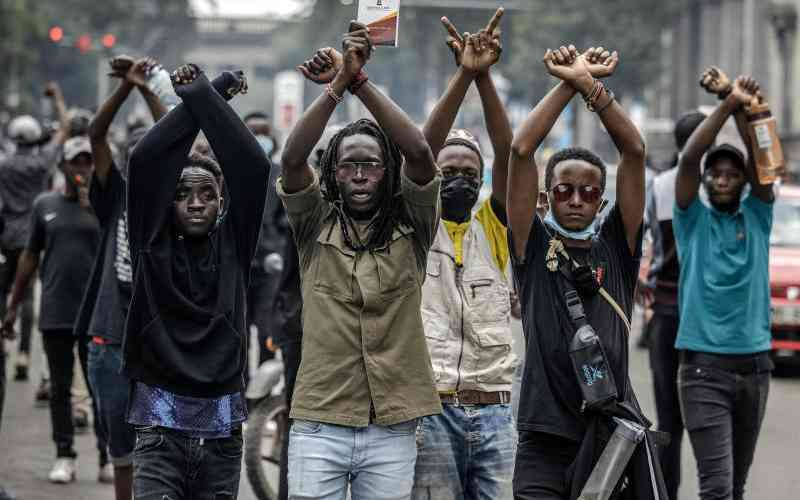
In 2023, notable strides for children in Kenya included deploying 100,000 community health promoters to strengthen primary healthcare.
President William Ruto committed to expanding Inua-Jamii cash transfers from 1.2 million to 2.5 million vulnerable households and the recently approved Social Protection Policy 2023 by the Cabinet.
Increased funding for climate change adaptation acknowledged the crucial link between climate resilience and the welfare of the most vulnerable amid drought and the El Nino effect. As we set resolutions for 2024, these achievements shape our reflections and aspirations.
Half of the nation's population comprises children, and a concerning 10.39 million are mired in multi-dimensional poverty, experiencing deprivation in areas such as housing, nutrition, water, sanitation, and protection.
Amid this, witnessing innocent children being withdrawn from school, denied food, and subjected to atrocities due to the influence of the religious cult teachings was particularly distressing, in clear violation of the Children's Act 2022.
In 2023, 12 million children suffered from the impacts of climate change, and their lives were upended by droughts and floods. A total of 6.4 million people sought humanitarian aid, facing both natural disasters and economic challenges. Escalating living costs intensified food insecurity, pushing vulnerable communities to the edge.
The number of children under five requiring malnutrition treatment surged by 10 per cent, reaching one million, compared to 2022. Amid these challenges, alarming statistics underscore the need for urgent action. With a 64 per cent debt-to-GDP ratio and the Kenyan shilling depreciating, tax collection, vital for a nation under fiscal strain, presents a dilemma.
Approximately 30 per cent of domestic revenue comes from taxes, particularly VAT and fees. It's crucial that any increased taxation doesn't disproportionately burden the poor and vulnerable relative to their income.
The fiscal consolidation imperative, achieved through increased taxation and debt payments, paradoxically jeopardizes the government's ability to invest in critical social sectors. This poses the ominous risk of reduced budgets for education, health, social protection, water, and sanitation, potentially exacerbating child poverty and undermining progress towards the Sustainable Development Goals by 2030.
Key indicators underscore the challenge: an 18 per cent stunting rate among under-five children, 80 per cent vaccination coverage, one in two children affected by violence, 15 per cent of girls facing the threat of Female Genital Mutilation, 418,000 girls affected by teenage pregnancy, and a staggering 2.5 million out-of-school children.
The drafting of the 2024/25 budget is critical for preserving children's well-being and maintaining existing progress. Prioritising social services is imperative in the fiscal landscape. Resource allocation must align with the need to shield vulnerable groups, preventing disproportionate impacts on children, women, and the poorest in our community amid increased taxation burdens.
Adjusting public service fees, such as those for birth registration, requires a delicate balance to avoid a scenario where the economic and social costs outweigh revenue benefits. Analysis indicates that reducing or eliminating registration fees can enhance efficiencies and boost coverage rates. For instance, the government could save 500 Kenya Shillings for every 50 Kenya Shillings waived in fees.
Safeguarding investments in children, particularly in Arid and semi-Arid (ASAL) regions where 80 per cent of children endure poverty amid ongoing climate shocks, is crucial. Despite incremental progress, a slight reduction in child poverty (from 52 percent in 2015 to 47.7 per cent now) is at risk due to the potential overshadowing effect of fiscal prioritization, especially in debt repayment.
Stay informed. Subscribe to our newsletter
Prioritising the most vulnerable in fiscal strategies at national and county levels is imperative, as investing in children yields the highest returns. Targeted cash transfers, especially through expanding the Inua Jamii program, effectively protect children and enhance access to services.
Currently, only 13 percent of cash transfer recipients in Kenya are children, a stark contrast to their 50 percent population representation, with half of them in poverty. Aligning with demographic reality, a crucial step is to increase child beneficiaries by at least 350,000 annually over the next two years, a 15 per cent boost, directly alleviating child deprivations.
Moving forward, it is crucial to build on the successes of 2023 and address persistent challenges facing Kenyan children. Prioritizing investments in education, healthcare, and social protection will be pivotal in forging a more equitable and prosperous future.
Fulfilling this promise represents one of the most impactful investments in the economy, aligning with the Kenya Children's Act. It is time to enact these commitments, setting up our children and our country for success and laying the foundation for a thriving and resilient society.
It's time for a conscientious shift in budgetary allocations, ensuring that present needs do not overshadow future imperatives. Let 2024 be the year when fiscal priorities and child well-being seamlessly intertwine-not just a budget line item but a testament to the nation's commitment to securing a brighter future for its most precious resource. Let it be a year dedicated to ensuring that no child is left behind.
-Twitter: @ShaheenSnilofer
 The Standard Group Plc is a
multi-media organization with investments in media platforms spanning newspaper
print operations, television, radio broadcasting, digital and online services. The
Standard Group is recognized as a leading multi-media house in Kenya with a key
influence in matters of national and international interest.
The Standard Group Plc is a
multi-media organization with investments in media platforms spanning newspaper
print operations, television, radio broadcasting, digital and online services. The
Standard Group is recognized as a leading multi-media house in Kenya with a key
influence in matters of national and international interest.
 The Standard Group Plc is a
multi-media organization with investments in media platforms spanning newspaper
print operations, television, radio broadcasting, digital and online services. The
Standard Group is recognized as a leading multi-media house in Kenya with a key
influence in matters of national and international interest.
The Standard Group Plc is a
multi-media organization with investments in media platforms spanning newspaper
print operations, television, radio broadcasting, digital and online services. The
Standard Group is recognized as a leading multi-media house in Kenya with a key
influence in matters of national and international interest.





